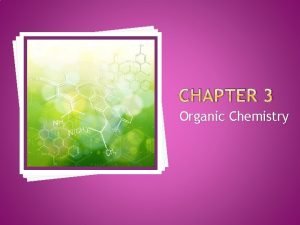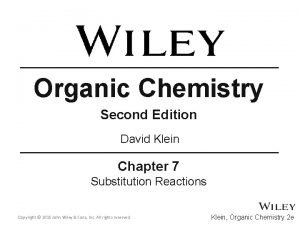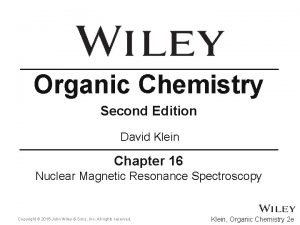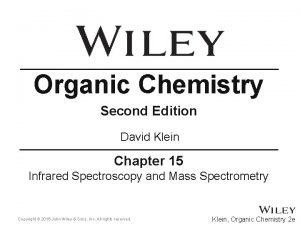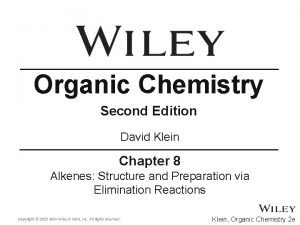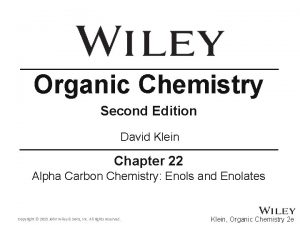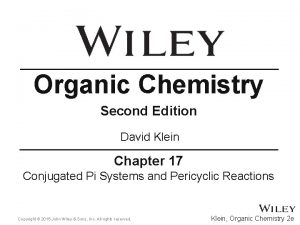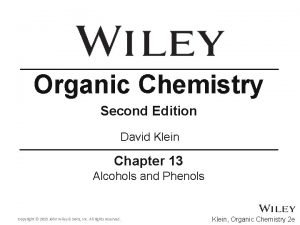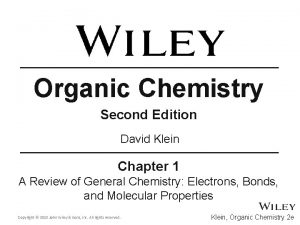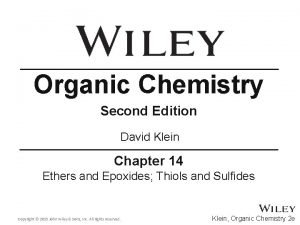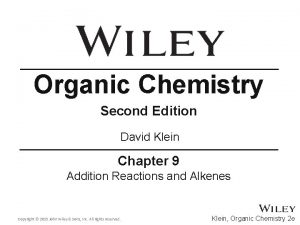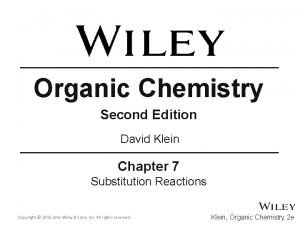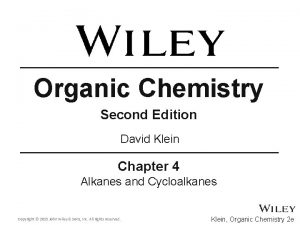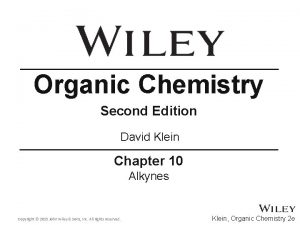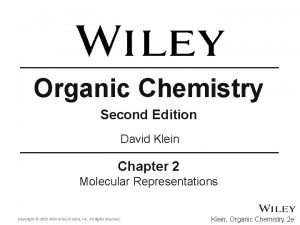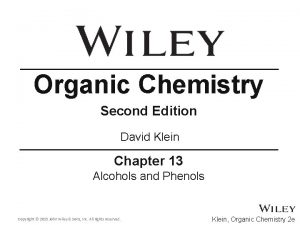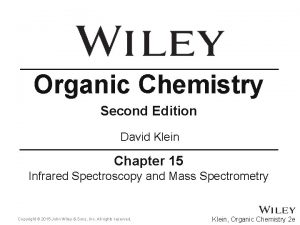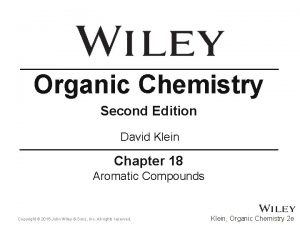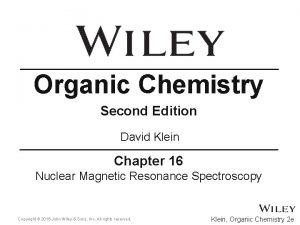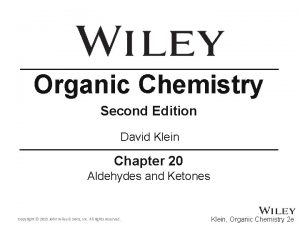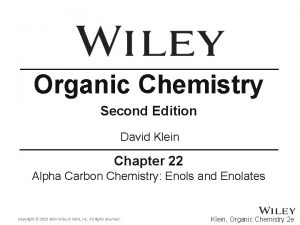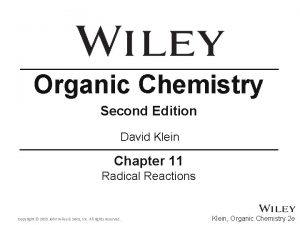Organic Chemistry Second Edition David Klein Chapter 24

































- Slides: 33

Organic Chemistry Second Edition David Klein Chapter 24 Carbohydrates Copyright © 2015 John Wiley & Sons, Inc. All rights reserved. Klein, Organic Chemistry 2 e

24. 1 Introduction to Carbohydrates • Carbohydrates (sugars) are abundant in nature – High energy biomolecules – Provide structural rigidity for organisms (plants, crustaceans, etc. ) – The polymer backbone on which DNA and RNA are assembled – Expressed on cells so they can recognize one another • The term, carbohydrate, evolved to describe the formula for such molecules: Cx(H 2 O)x • Carbohydrates are NOT true hydrates. WHY? Copyright © 2015 John Wiley & Sons, Inc. All rights reserved. 24 -2 Klein, Organic Chemistry 2 e

24. 1 Introduction to Carbohydrates • Carbohydrates (sugars) are polyhydroxy aldehydes or ketones • Consider glucose, which is made by plants • Describe the potential energy change that occurs during glucose photosynthesis • Is glucose a polyhydroxy aldehyde or ketone? Copyright © 2015 John Wiley & Sons, Inc. All rights reserved. 24 -3 Klein, Organic Chemistry 2 e

24. 2 Classification of Monosaccharides • Saccharides have multiple chiral centers, and they are often expressed as Fischer projections • What does the suffix, “ose” mean? • Define the following terms: • Aldose and ketose • Pentose and hexose • Practice conceptual checkpoints 24. 1 and 24. 2 Copyright © 2015 John Wiley & Sons, Inc. All rights reserved. 24 -4 Klein, Organic Chemistry 2 e

Copyright © 2015 John Wiley & Sons, Inc. All rights reserved. Klein, Organic Chemistry 2 e

24. 2 Classification of Monosaccharides • Glyceraldehyde is a monosaccharide with one chirality center • Natural glyceraldehyde is dextrorotatory (D) – it rotates plane polarized light in the clockwise direction • Does the direction plane polarized light is rotated necessarily tell us whether it is (R) or (S)? Copyright © 2015 John Wiley & Sons, Inc. All rights reserved. 24 -6 Klein, Organic Chemistry 2 e

24. 2 Classification of Monosaccharides • Naturally occurring larger sugars can be broken down into glyceraldehyde by degradation • Such sugars are often called D sugars Copyright © 2015 John Wiley & Sons, Inc. All rights reserved. 24 -7 Klein, Organic Chemistry 2 e

24. 2 Classification of Monosaccharides • Recall that dextrorotatory versus levorotatory rotation can not be predicted by the R or S configuration • Here, D no longer refers to dextrorotatory. Rather it refers to the R configuration at the chiral carbon farthest from the carbonyl • Practice conceptual checkpoints 24. 3 through 24. 6 Copyright © 2015 John Wiley & Sons, Inc. All rights reserved. 24 -8 Klein, Organic Chemistry 2 e

Copyright © 2015 John Wiley & Sons, Inc. All rights reserved. Klein, Organic Chemistry 2 e

24. 3 Configuration of Aldoses • There are four aldotetroses. Two are shown below • What are the other two structures? Copyright © 2015 John Wiley & Sons, Inc. All rights reserved. 24 -10 Klein, Organic Chemistry 2 e

24. 3 Configuration of Aldoses • Aldopentoses have three chirality centers. The number of isomers will be 23 • Recall the 2 n rule from section 5. 5 • The D sugars are naturally occurring Copyright © 2015 John Wiley & Sons, Inc. All rights reserved. 24 -11 Klein, Organic Chemistry 2 e

24. 3 Configuration of Aldoses • • Ribose is a key building block of RNA WHAT is RNA? More detail to come in section 24. 10 Arabinose is found in plants Xylose is found in wood Copyright © 2015 John Wiley & Sons, Inc. All rights reserved. 24 -12 Klein, Organic Chemistry 2 e

24. 3 Configuration of Aldoses • • Based on the 2 n rule, how many aldohexoses are there? How many of the aldohexoses are D isomers Glucose is the most common aldohexose Manose and Galactose are also common Copyright © 2015 John Wiley & Sons, Inc. All rights reserved. 24 -13 Klein, Organic Chemistry 2 e

24. 4 Configuration of Ketoses • Relevant ketoses have between 3 and 6 carbons • For each naturally occurring D isomer, there is an L enantiomer Copyright © 2015 John Wiley & Sons, Inc. All rights reserved. 24 -14 Klein, Organic Chemistry 2 e

24. 4 Configuration of Ketoses Copyright © 2015 John Wiley & Sons, Inc. All rights reserved. 24 -15 Klein, Organic Chemistry 2 e

24. 5 Cyclic Structures of Monosaccharides • Recall from section 20. 5 that carbonyls can be attacked by alcohols to form hemiacetals • The intermolecular reaction is not favored. WHY? • The intramolecular reaction is generally favored for 5 and 6 -membered rings. WHY? • Practice with Skill. Builder 24. 1 Copyright © 2015 John Wiley & Sons, Inc. All rights reserved. 24 -16 Klein, Organic Chemistry 2 e

Copyright © 2015 John Wiley & Sons, Inc. All rights reserved. Klein, Organic Chemistry 2 e

24. 5 Cyclic Structures of Monosaccharides • Monosaccharides like glucose can also undergo ringclosing hemiacetal formation • The equilibrium greatly favors the closed form called pyranose Copyright © 2015 John Wiley & Sons, Inc. All rights reserved. 24 -18 Klein, Organic Chemistry 2 e

24. 5 Cyclic Structures of Monosaccharides • What is the relationship between alpha and beta forms? Copyright © 2015 John Wiley & Sons, Inc. All rights reserved. 24 -19 Klein, Organic Chemistry 2 e

24. 5 Cyclic Structures of Monosaccharides • Distinguish between the α and β anomers [a]D = +112. 2˚ Copyright © 2015 John Wiley & Sons, Inc. All rights reserved. [a]D = +18. 7˚ 24 -20 Klein, Organic Chemistry 2 e

24. 5 Cyclic Structures of Monosaccharides • You should be able to draw monosaccharide structures in their various forms • Draw the chair form D-Galactose • Practice with Skill. Builder 24. 3 Copyright © 2015 John Wiley & Sons, Inc. All rights reserved. 24 -21 Klein, Organic Chemistry 2 e

Copyright © 2015 John Wiley & Sons, Inc. All rights reserved. Klein, Organic Chemistry 2 e

Copyright © 2015 John Wiley & Sons, Inc. All rights reserved. Klein, Organic Chemistry 2 e

Copyright © 2015 John Wiley & Sons, Inc. All rights reserved. Klein, Organic Chemistry 2 e

Copyright © 2015 John Wiley & Sons, Inc. All rights reserved. Klein, Organic Chemistry 2 e

24. 5 Cyclic Structures of Monosaccharides • Ketoses form both furanose (5 -membered) and pyranose (6 -membered) rings Copyright © 2015 John Wiley & Sons, Inc. All rights reserved. 24 -26 Klein, Organic Chemistry 2 e

24. 5 Cyclic Structures of Monosaccharides • The furanose form takes part in most biochemical reactions • Practice with conceptual checkpoints 24. 22 through 24. 25 Copyright © 2015 John Wiley & Sons, Inc. All rights reserved. 24 -27 Klein, Organic Chemistry 2 e

24. 6 Reactions of Monosaccharides • Monosaccharides are generally soluble in water. WHY? • To improve their solubility in organic solvents, the hydroxyl groups can be acetylated • WHY is pyridine added to the reaction? • How might acetylation help in purification efforts? Copyright © 2015 John Wiley & Sons, Inc. All rights reserved. 24 -28 Klein, Organic Chemistry 2 e

24. 6 Reactions of Monosaccharides • Monosaccharides can also be converted to ethers via the Williamson ether synthesis • Ether linkages are more robust than ester linkages. WHY? • Practice with conceptual checkpoints 24. 26 and 24. 27 Copyright © 2015 John Wiley & Sons, Inc. All rights reserved. 24 -29 Klein, Organic Chemistry 2 e

24. 6 Reactions of Monosaccharides • When treated with an excess of an alcohol, the hemiacetal equilibrium can be shifted to give an acetal • When a sugar is used, alpha and beta glycosides are formed Copyright © 2015 John Wiley & Sons, Inc. All rights reserved. 24 -30 Klein, Organic Chemistry 2 e

24. 6 Reactions of Monosaccharides • The mechanism of glycoside formation is analogous to the acetal formation mechanism • Only the anomeric hydroxyl group is replaced Copyright © 2015 John Wiley & Sons, Inc. All rights reserved. 24 -31 Klein, Organic Chemistry 2 e

24. 6 Reactions of Monosaccharides • The mechanism of glycoside formation is analogous to the acetal formation mechanism • Practice with conceptual checkpoints 24. 28 and 24. 29 Copyright © 2015 John Wiley & Sons, Inc. All rights reserved. 24 -32 Klein, Organic Chemistry 2 e

Copyright © 2015 John Wiley & Sons, Inc. All rights reserved. Klein, Organic Chemistry 2 e
 Klein
Klein Rearranged most stable carbocation is
Rearranged most stable carbocation is David klein organic chemistry 3rd edition
David klein organic chemistry 3rd edition Organic chemistry third edition david klein
Organic chemistry third edition david klein Organic chemistry third edition david klein
Organic chemistry third edition david klein Organic chemistry 2nd edition klein
Organic chemistry 2nd edition klein Thermodynamic control
Thermodynamic control Organic chemistry (3rd) edition chapter 1 problem 16s
Organic chemistry (3rd) edition chapter 1 problem 16s Halohydrin formation
Halohydrin formation Ib chemistry organic chemistry
Ib chemistry organic chemistry Organic vs inorganic chemistry
Organic vs inorganic chemistry Organic chemistry introduction
Organic chemistry introduction Chapter 22 review organic chemistry section 1 answers
Chapter 22 review organic chemistry section 1 answers Organic chemistry chapter 9
Organic chemistry chapter 9 Chapter 7 chemistry review
Chapter 7 chemistry review This name
This name Analytical chemistry chapter 1
Analytical chemistry chapter 1 David klein
David klein David klein
David klein Father of organic chemistry
Father of organic chemistry Chemistry of soap making
Chemistry of soap making Ester organic chemistry
Ester organic chemistry Formula of alkene
Formula of alkene Ee organic chemistry
Ee organic chemistry Leveling effect organic chemistry
Leveling effect organic chemistry Ario practice problems
Ario practice problems Iupac nomenclature
Iupac nomenclature Organic chemistry lab report example
Organic chemistry lab report example Www.masterorganicchemistry.com
Www.masterorganicchemistry.com Organic chemistry grade 10
Organic chemistry grade 10 Cyclo organic chemistry
Cyclo organic chemistry Organic chemistry wade
Organic chemistry wade Met eth prop
Met eth prop Alkane cracking
Alkane cracking















